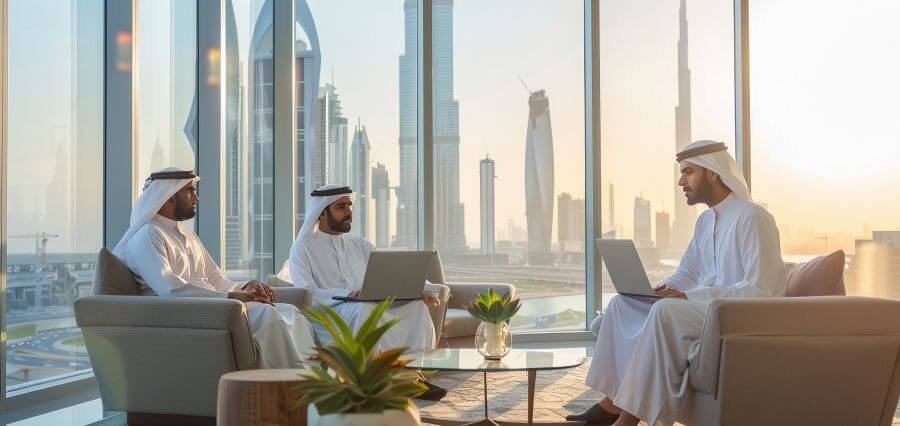It is the dependence on a single point of income that undermines the economy of a country, particularly if it’s non-renewable. Therefore, effective utilization of economic diversification is the need if an economy is to become prosperous in the long run. For the improvement of the institutions of a country, the living standards of its population, and its attractiveness in general, the solution is diversification. Since all members of the Gulf Cooperation Council (GCC) have a similar aspiration to keep their future generations with high and stable standards of living, all are stepping up their economic diversification efforts. This article focuses on the diversification policies of Arab Economies.
What are Diversification Strategies?
The overall efficiency of the economy is made better by diversification and resource reallocation out of low-productivity into high-productivity economic activity. The capacity of the fiscal mechanism to perform resource reallocation is vital to the process. Stimulating the quality of the labor force and to what extent the skills of the labor force remain applicable to high-value-added economic activity and the country’s needs are also key areas to facilitate structural change and diversification.
The Diversification Imperative: The Arab economies, being traditionally oil-exporting-dependent, have been subjected to volatility with changes in oil prices. In acknowledging the vulnerability of thus depending, most Arab nations pursue active diversification strategies as a means of alleviating economic vulnerability to risks. The diversification imperative arises from the necessity of enhancing resilience, initiating sustainable growth and achieving a balanced and stable economic base.
Example: For January 2024, the World Bank puts another decrease in the proportion of oil rents in the Middle East and North Africa (MENA) GDP, indicating a further decline away from oil dependency.
Technology and Innovation Hubs: Arab nations are making significant investments to become technology and innovation hubs. The United Arab Emirates (UAE) and Saudi Arabia have established free zones and clusters of innovation to attract global tech companies and encourage local start-ups. Dubai’s ‘Smart Dubai’ and Saudi Arabia’s ‘Vision 2030’ are programmes that reflect a vision to create innovation-driven economies.
For instance, Dubai Silicon Oasis (DSO) in the UAE has emerged as a successful technology park with the presence of companies like HP, Schneider Electric, and Oracle.
Economic Challenges and Global Trends: The Arab world has been faced with large-scale economic challenges, the most prominent of which are population pressures, unemployment among youth and the requirement for infrastructural development. Global trends, including the rise of renewable energy, have also pushed Arab nations towards rethinking their economic models. Policies of diversification are perceived as a solution to these challenges, providing the way towards economic change and inclusive growth.
Example: Qatar spent 2.8% of GDP on education in 2019, according to the World Bank. Saudi Arabia’s King Abdullah University of Science and Technology (KAUST) is among the world’s top research universities driving innovation.
Renewable Energy Projects: International shifts toward sustainable practices have encouraged some Arab nations to pursue renewable energy sources. Since there is sufficient sunlight, wind, and land, nations such as the UAE and Morocco are pioneering the solar and wind power ventures. The ventures, in addition to encouraging environmental sustainability, also provide opportunities for economic diversification. Example: The UAE has the world’s highest per capita installed solar capacity of 1,900 watts per capita, according to IRENA. Morocco’s Noor Solar Complex is among the world’s top largest concentrated solar power plants and puts the nation on the right track with its renewable energy project.
Tourism and Hospitality Development: Tourism is the best sector for diversification for the majority of the Arab economies. Recognizing the cultural and historical wealth in their lands, countries like Egypt, Jordan, and Oman are establishing tourism infrastructure. Mega-projects like Saudi Arabia’s NEOM and the Red Sea Project aim to focus on these countries as master tourist places, diversifying revenue streams and creating employment.
Example: The expansion of travel and tourism in Saudi Arabia’s GDP will increase at a rate of 3.9% per annum between 2021 and 2030, according to the WTTC estimates. Saudi Arabia’s mega tourism projects Red Sea Project and NEOM will welcome international visitors.
Agriculture and Food Security Initiatives: The Arab region is investing in the agriculture initiatives because of food security. Sustainable agriculture, vertical farming, and aquaculture are on the increase. Qatar National Food Security Program and the UAE National Food Security Strategy are working towards improving self-sufficiency and decreasing dependence on foreign food.
Example: Qatar National Food Security Programme vision is becoming self-sufficient in poultry and dairy production by 2023.
Cultural and Creative Industries: Arab countries are investing in media, arts, and entertainment to explore the value of cultural and creative industries. Dubai Design District (d3) and regional cinema festivals are cultivating regional talents and attracting international interest. These initiatives diversify the economy and represent the rich cultural heritage of the Arab world. Example: The creative and cultural industries have added £8.8 billion to the UK economy over recent years, the Department for Digital, Culture, Media, and Sport reports. Dubai Design District (d3) is becoming a hub for creative industries with designers, artists, and entrepreneurs moving there. Final Remarks Arab economies, diversifying at a strategic level, are not merely reacting to change but making their own fate. Statistical evidence and real-life experiences validate the effectiveness of diversification policies as vehicles for sustainable development. In pursuing this process of change, Arab nations, its consequences on their economic pictures reverberate not only in the region but in the world.
Read More – Middle East Leadership Development 2025: Strategies That Empower





